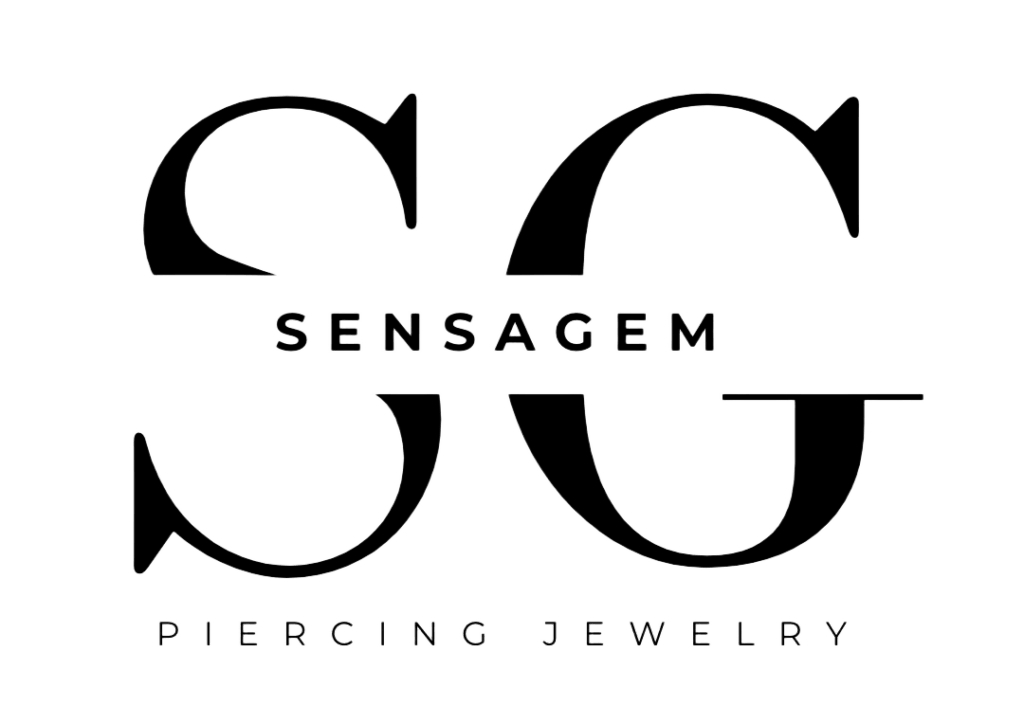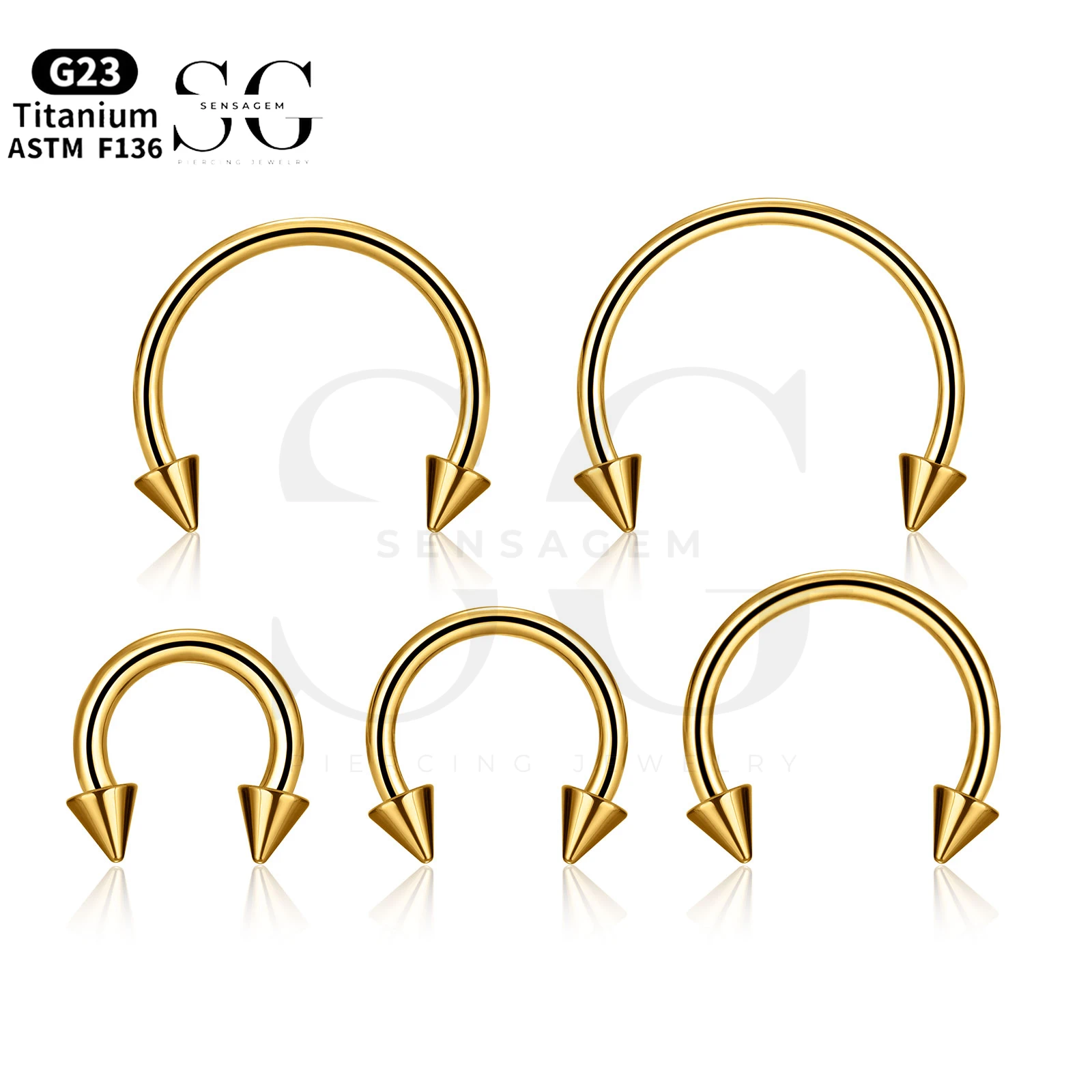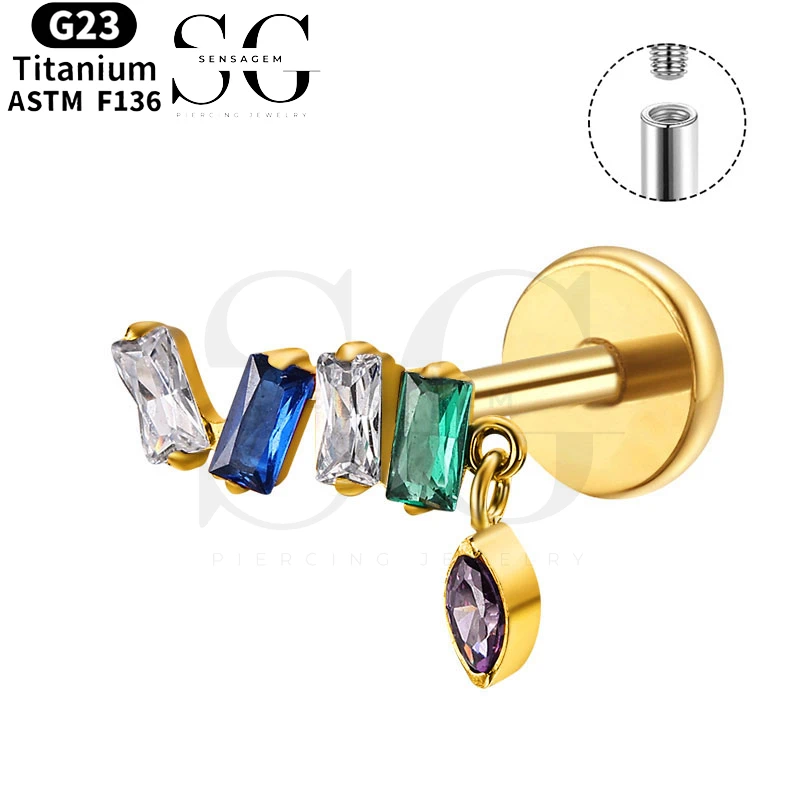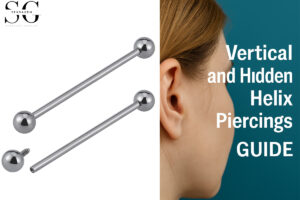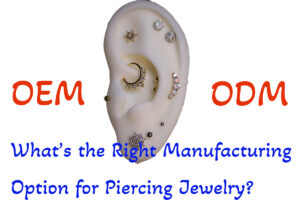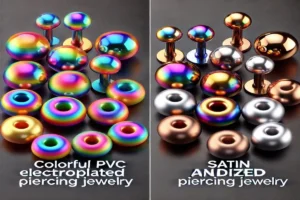Einführung
In den letzten Jahren, Ohrpiercings haben sich weit über das traditionelle Ohrläppchen hinaus entwickelt. Immer mehr Menschen suchen nach kreativen Möglichkeiten, ihren Look zu personalisieren, und zwei aufstrebende Sterne in der Piercing-Welt sind die Vertikales Helix-Piercing und die Hidden-Helix-Piercing. Diese Stile sind nicht nur optisch auffällig, sondern bieten Kunden auch neue Möglichkeiten, sich durch einzigartige Platzierung und speziellen Schmuck auszudrücken.
In diesem Leitfaden, Wir werden die Unterschiede zwischen vertikalen und versteckten Helix-Piercings aufschlüsseln, begleiten Sie durch den Eingriff und den Heilungsprozess, und entdecken Sie die Arten von Schmuck, die am besten funktionieren – besonders versteckter Helix-Schmuck, was sich immer größerer Beliebtheit erfreut.
Was ist ein vertikales Helix-Piercing??
Der Vertikales Helix-Piercing ist eine kühne Variante der Standardhelix. Anstelle einer traditionellen horizontalen Platzierung, die direkt durch den Knorpel am äußeren Rand des Ohrs geht, Eine vertikale Helix ist in einem aufrechteren durchbohrten, Top-to-Bottom-Richtung.
Dies gibt ihm einen Schlag, moderner Look und ermöglicht kreative Schmuckpaarungen. Während immer noch als Knorpelpiercing angesehen wird, Die vertikale Helix eröffnet Piercers und Kunden gleiche Möglichkeiten.
Schlüsselmerkmale:
Platzierung: Außenohr, vertikal durchbohrt (oben nach unten).
Schmucktypen: Hanteln, gebogene Langhantel, oder benutzerdefinierte vertikale Stücke.
Heilzeit: 6 Zu 12 Monate, Abhängig von der Nachsorge und der Anatomie.
Vertikale Helix -Piercings können je nach Form des Ohrs des Kunden und ihrer gewünschten Ästhetik angepasst werden. Einige Leute bevorzugen eine nach vorne gerichtete vertikale Platzierung, um den Schmuck wirklich zu präsentieren.
Was ist ein verstecktes Helix -Piercing?
Hidden Helix Piercing ist heute eines der angesagtesten und geheimnisvollsten Ohrpiercings. Wie der Name schon sagt, Es ist strategisch in einem Teil des Ohrs platziert, sodass es teilweise oder vollständig verborgen ist, vor allem von vorne.
Kunden lieben die versteckte Helix oft, weil sie sich wie ein geheimes Accessoire anfühlt – eines, das subtil ist, elegant, und unerwartet. Es ist die perfekte Wahl für Menschen, die sich ein Piercing wünschen, das nicht sofort auffällt, aber dennoch Persönlichkeit und Eleganz verleiht.
Schlüsselmerkmale:
Platzierung: Normalerweise hinter dem oberen Knorpelrücken oder an der Unterseite der Helix.
Schmuck: Labrets mit flacher Rückseite oder Mikro-Nieten, oft aus Titan oder Chirurgenstahl.
Heilzeit: Ähnlich wie bei anderen Helix-Piercings, ca. 6–12 Monate.
Abhängig von der Platzierung, Hidden Helix Piercings erfordern möglicherweise ein bisschen mehr Fähigkeiten als Piercer und ein gutes Verständnis der Anatomie des Kunden. Aber wenn es gut gemacht wird, Das Ergebnis ist atemberaubend.
Vertikal gegen versteckte Helix -Piercing: Was ist der Unterschied??
Während sich beide Piercings im Helixbereich befinden, Ihre Präsentation und ästhetische Auswirkungen sind ganz anders.
Besonderheit | Vertikale Helix -Piercing | Hidden Helix Piercing |
|---|---|---|
Sichtweite | Aus den meisten Blickwinkeln vollständig sichtbar | Oft versteckt oder teilweise sichtbar |
Schmucktyp | Hanteln, gebogene Langhantel | Flachböde, Fadenlose Enden |
Ästhetisch | Deutlich, strukturiert, kantigem Look | Subtil, mysteriös, minimalistisch |
Heilzeit | 6–12 Monate | 6–12 Monate |
Anatomie braucht | Mäßig | Kann mehr benutzerdefinierte Bewertung erfordern |
Kunden, die zwischen diesen beiden Stilen wählen, stützen ihre Entscheidung normalerweise auf den Lebensstil, Modepräferenzen, und das Maß an Sichtbarkeit, mit dem sie sich wohl fühlen.
Auswahl des richtigen Schmucks für Helix Piercings
Kein Piercing ist komplett ohne den richtigen Schmuck, und wenn es um vertikale und versteckte Helix-Piercings geht, Die Wahl des passenden Stücks macht den Unterschied in Bezug auf Komfort und Heilung aus.
Für vertikales Helix-Piercing:
Gebogene Hanteln helfen, den Druck während der Heilung zu reduzieren.
Titan oder 316L Chirurgenstahl wird aus Gründen der Biokompatibilität empfohlen.
Minimalistische Designs oder doppelseitige Stücke kann eine saubere erstellen, Industrie-Look.
Für Hidden Helix Piercing:
Labrets mit flacher Rückseite werden für einen bündigen Abschluss bevorzugt, der ein Hängenbleiben minimiert.
Fadenloser Schmuck wird aufgrund seines Komforts und seiner Benutzerfreundlichkeit zum Standard.
Kleiner, diskrete Nieten sind ideal für alle, die einen minimalistischen Look wünschen.
Raten Sie Ihren Klienten immer, während der Heilung auf billige Materialien oder Schmuck mit Außengewinde zu verzichten. Für beste Ergebnisse, Wir empfehlen Titan ASTM F136 oder Stahl in Implantatqualität.
Tipps zum Heilungsprozess und zur Nachsorge
Wie alle Knorpelpiercings, vertikale und versteckte Helix-Piercings Für eine gute Heilung sind Geduld und die richtige Pflege erforderlich. Knorpelgewebe wird weniger durchblutet als andere Teile des Ohrs, Heilung kann also überall stattfinden 6 Zu 12 Monate, Abhängig von der Person und ihren Gewohnheiten.
Allgemeine Nachsorgeroutine:
Zweimal täglich reinigen mit steriler Kochsalzlösung.
Vermeiden Sie es, auf der Piercing-Seite zu schlafen für die ersten paar Monate.
Drehen oder bewegen Sie den Schmuck nicht– Dies kann die Heilung verzögern.
Vermeiden Sie Schwimmbäder und Whirlpools während der ersten Heilungsphase.
Trocknen Sie den Bereich immer vorsichtig ab nach dem Duschen.
Für Hidden-Helix-Piercings, Es ist besondere Vorsicht geboten, da die Platzierung die Reinigung erschweren kann. Weisen Sie die Kunden an, bei Bedarf das Außenohr vorsichtig anzuheben, um Zugang zur Piercingstelle zu erhalten.
Anzeichen von Problemen:
Anhaltende Rötung oder Schwellung nach den ersten Wochen.
Gelber oder grüner Ausfluss (im Gegensatz zu klarer Lymphe).
Übermäßiger Schmerz oder ein warmes Gefühl an der Piercingstelle.
Ermutigen Sie Kunden immer, sich an ihren Piercer oder einen Arzt zu wenden, wenn sie sich über die Symptome nicht sicher sind.
Häufige Fehler zu vermeiden
Selbst erfahrene Klienten können Fehler machen, die die Heilung verlangsamen oder Komplikationen verursachen. Stellen Sie sicher, dass Sie sie darüber aufklären nicht zu tun:
Den Schmuck zu früh gewechselt: Das Wechseln des Schmucks, bevor das Piercing vollständig verheilt ist, kann zu Reizungen oder Infektionen führen.
Verwendung aggressiver Produkte: Vermeiden Sie Alkohol oder Wasserstoffperoxid, was das Gewebe austrocknen kann.
Berühren mit ungewaschenen Händen: Dies ist eine der schnellsten Möglichkeiten, Bakterien einzuschleppen.
Tragen Sie enge Kopfhörer oder Helme: Druck und Reibung können Knorpelpiercings reizen, vor allem versteckte.
Als Piercer, Eine klare Kommunikation über die Nachsorge ist eine der besten Möglichkeiten, um glücklich zu sein, Stammkunden.
So stylen Sie vertikalen und versteckten Helix-Schmuck
Beim Styling macht es Spaß. Sobald das Piercing geheilt wird, Kunden können ihre Persönlichkeit mit einer breiten Auswahl an Schmuckstücken zum Ausdruck bringen.
Styling vertikaler Helix-Piercings:
Gestapelte Hanteln in passenden oder kontrastierenden Metallen.
Gebogene Hanteln mit dekorativen Enden (z.B., Opale, Spikes, Edelsteine).
Industriell inspirierte Stücke für eine alternativere Ästhetik.
Styling von Hidden-Helix-Piercings:
Minimalistische Nieten in Gold oder schwarzem Titan für einen dezenten Look.
Fadenlose Enden mit kleinen Edelsteinen das direkt unter der Ohrmuschel funkelt.
Asymmetrische Designs die andere sichtbare Piercings ausspielen.
Die Hidden Helix bietet Kunden eine einzigartige Gelegenheit, Subtilität mit Stil zu verbinden. Viele nutzen es als verstecktes Juwel, das einen besser sichtbaren Ear Stack ergänzt.
Trends und Kundenpräferenzen in 2025
Die Piercing-Branche entwickelt sich rasant, und beides vertikale Helix Und versteckte Helix Piercings stehen bei diesem Trend im Vordergrund. Kunden sind zunehmend auf der Suche:
Einzigartige Platzierungen die sich persönlich und frisch anfühlen.
Unauffälliger Schmuck das zu ihrer Arbeit oder ihrem Lebensstil passt.
Hochwertige Materialien die eine schnellere Heilung fördern und das Risiko von Allergien verringern.
Auch professionelle Studios investieren mehr in fadenlose Schmucksysteme Und biokompatible Metalle wie ASTM F136 Titan und 316L Chirurgenstahl. Diese Materialien erfüllen nicht nur die Erwartungen der Kunden, sondern spiegeln auch die Professionalität und Sorgfalt des Studios wider.
Profi -Tipps für professionelle Piercer
Wenn Sie ein Piercer sind, der Ihr Angebot erweitern möchte, Hier sind ein paar Tipps zum Meister vertikale und versteckte Helix-Piercings:
Bewerten Sie die Anatomie der Kunden sorgfältig. Nicht jedes Ohr ist für jede Platzierung geeignet.
Verwenden Sie die richtigen Werkzeuge. Abgewinkelte Pinzette und gerade Nadeln können mehr Präzision bieten.
Beginnen Sie mit hochwertigem Schmuck. Wählen Sie intern eingefädelte oder fadenlose Optionen in Titan- oder Operationsstahl aus.
Bieten Sie Styling -Konsultationen an. Helfen Sie Ihren Kunden, sich vorzustellen, wie ihre Helix -Piercings mit anderen aussehen werden.
Realistische Erwartungen setzen. Seien Sie ehrlich über die Heilungszeiten und betonen Sie die Bedeutung der Nachsorge.
EXACHSCHAFTEN ERGEBNISSE, Saubere Technik, Und Expertenberatung hilft dabei.
